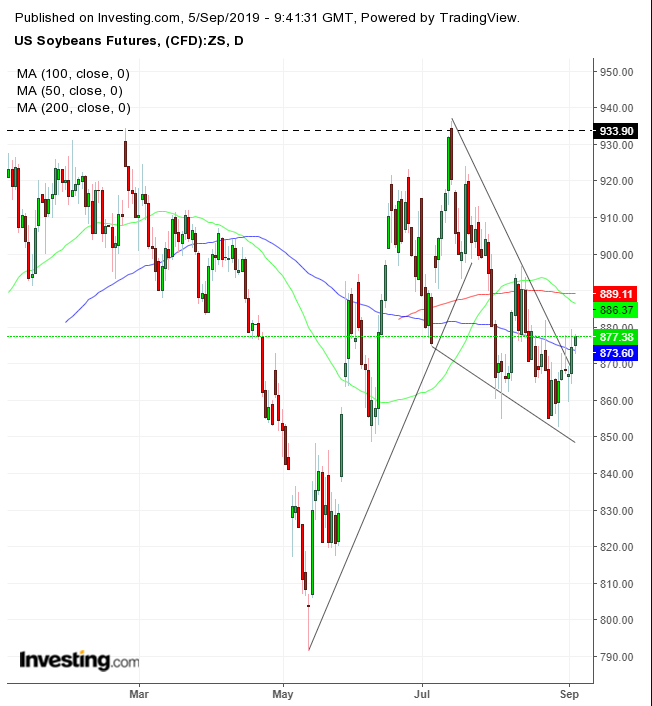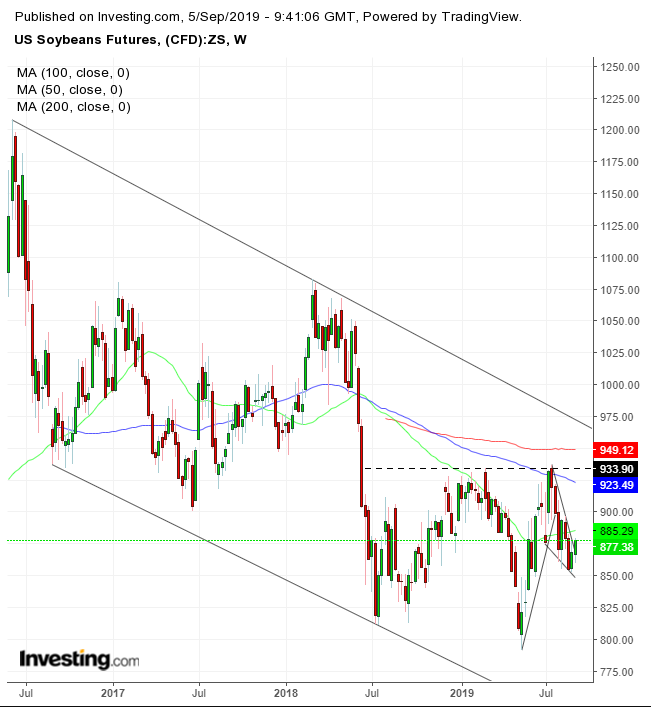
- All Instrument Types
- Indices
- Equities
- ETFs
- Funds
- Commodities
- Currencies
- Crypto
- Bonds
- Certificates
Please try another search

Chart Of The Day: Soybeans Set To Surge On China Demand, Hurricane Dorian

The price of soybeans is about to jump as China finds itself out of options for sourcing the commodity other than once again importing them from the U.S. despite the trade war. Adding to price pressures, the path of Hurricane Dorian now threatens soy, corn and cotton fields in Georia and the Carolinas as it heads north.
In retaliation for U.S. tariffs levied on Chinese goods during the first round of trade hostilities in 2018, the Asian nation took its business elsewhere, importing the commodity—a key component of the national diet—from Brazil. However, with the South American supply thinning, China is now forced to resume importing soybeans from the U.S.
The technical chart clearly shows soybeans' transition from a depressed market into one that's about to break out.
Soybean futures broke to the topside of a falling wedge, bullish after a $130.50, or 16.20% rise in the two months between the low of May 13 and the high of July 15. The pattern dynamics resemble that of another continuation pattern, a flag or pennant.
The downward bias is presumed to be led by profit takers, and the upside breakout suggests that all supply is spent while demand hungers for more, forcing them to increase bids to seek out willing sellers at higher prices. This signals to market participants that the previous sharp rise is about to reoccur.
Moreover, if the upside breakout will take on the July 15 high of $936.38, the price would complete a much larger, much more serious—bottom—pattern.
For over a year now, the price has been moving mostly sideways. An upside breakout of the July high would complete a bottom, threatening an upside breakout of a falling channel in place since June 2016, just before the UK Brexit vote. An upside breakout of that pattern would challenge the long-term downtrend since September 2012, from the height of just under $1,800.
Trading Strategies
Conservative traders would wait for the long-term bottom to complete before considering a long position.
Moderate traders may enter a long position after the price closes above the 200 DMA at $890 and retests the top of the pattern.
Aggressive traders could enter a long position at will, according to a trading plan that fits their account.
Trade Sample
Related Articles

Gold prices surged to an all-time high of $2,940 per ounce last Thursday, pushing its market cap above $20 trillion for the first time ever, as trade tensions between the U.S. and...

Gold remains at technically overbought levels across multiple time frames, with RSI showing negative divergence, signaling potential weakness. Gold’s strong correlation with the...

In 2024, central banks bought gold futures in a bullish tone amid growing concerns over the surge in geopolitical volatility at the global level if Donald Trump comes back to...
Are you sure you want to block %USER_NAME%?
By doing so, you and %USER_NAME% will not be able to see any of each other's Investing.com's posts.
%USER_NAME% was successfully added to your Block List
Since you’ve just unblocked this person, you must wait 48 hours before renewing the block.
I feel that this comment is:
Thank You!
Your report has been sent to our moderators for review






Add a Comment
We encourage you to use comments to engage with users, share your perspective and ask questions of authors and each other. However, in order to maintain the high level of discourse we’ve all come to value and expect, please keep the following criteria in mind:
Perpetrators of spam or abuse will be deleted from the site and prohibited from future registration at Investing.com’s discretion.